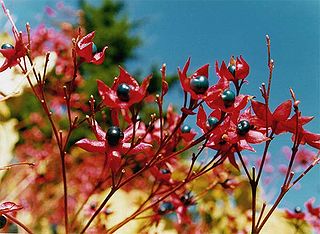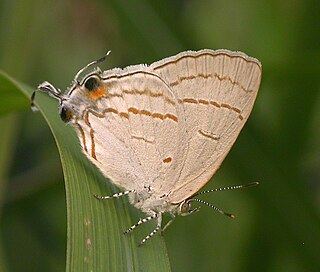
Jacaranda mimosifolia is a sub-tropical tree native to south-central South America that has been widely planted elsewhere because of its attractive and long-lasting violet-colored flowers. It is also known as the jacaranda, blue jacaranda, black poui, or fern tree. Older sources call it J. acutifolia, but it is nowadays more usually classified as J. mimosifolia. In scientific usage, the name "jacaranda" refers to the genus Jacaranda, which has many other members, but in horticultural and everyday usage, it nearly always means the blue jacaranda.

Leucospermum is a genus of evergreen upright, sometimes creeping shrubs that is assigned to the Proteaceae, with currently forty-eight known species. Almost all species are easily recognised as Leucospermum because of the long protruding styles with a thickened pollen-presenter, which jointly give the flower head the appearance of a pincushion, its common name. Pincushions can be found in South Africa, Swaziland, Zimbabwe and Mozambique.

Searsia pyroides, previously known as Rhus pyroides, is a species of Searsia, native to southern Africa. This tree occurs throughout the whole of South Africa, a part of Botswana, Zimbabwe and Tanzania and in some areas of Namibia near Windhoek.

Pittosporum is a genus of about 200 species of flowering plants in the family Pittosporaceae. The genus is probably Gondwanan in origin; its present range extends from Australasia, Oceania, eastern Asia and some parts of Africa. Citriobatus can be included here, but might be a distinct genus. They are commonly known as pittosporums or, more ambiguously, cheesewoods.

Volkameria is a genus of flowering plants in the family Lamiaceae. It is pantropical in distribution. Many of the species are found in coastal habitats.

Clerodendrum thomsoniae is a species of flowering plant in the genus Clerodendrum of the family Lamiaceae, native to tropical west Africa from Cameroon west to Senegal. It is an evergreen liana growing to 4 m (13 ft) tall, with ovate to oblong leaves 8–17 cm (3–7 in) cm long. The flowers are produced in cymes of 8-20 together, each flower with a pure white to pale purple five-lobed calyx 2.5 cm in diameter, and a red five-lobed corolla 2 cm long and in diameter. The flowers are born in cymose inflorescences arising from the axils of the leaves. The leaves, in turn, are arranged opposite to each other and at right angles to the pairs above and below.

Footscray Park is one of the largest and most intact examples of an Edwardian park in Australia. The 15-hectare park is located on the south bank of the Maribyrnong River in Footscray in Victoria. It is classified as a heritage place on the Victorian Heritage Register for its aesthetic, horticultural and social significance to the State of Victoria and was the first gardens to be placed on the register. The park is noted for its botanical collection, ornamental ponds and garden structures.

Clerodendrum is a genus of flowering plants formerly placed in the family Verbenaceae, but now considered to belong to the Lamiaceae (mint) family. Its common names include glorybower, bagflower and bleeding-heart. It is currently classified in the subfamily Ajugoideae, being one of several genera transferred from Verbenaceae to Lamiaceae in the 1990s, based on phylogenetic analysis of morphological and molecular data.
Stenochora is a genus of moths of the family Crambidae. It contains only one species, Stenochora lancinalis, the lanced pearl, which is found in southern and south-eastern Africa and the African islands of the Indian Ocean. The range includes Botswana, the Comoros, the Democratic Republic of Congo, La Réunion, Madagascar, Mauritius, Mozambique, the Seychelles (Aldabra), South Africa, Tanzania, Zambia and Zimbabwe.

Corymbium is a genus of flowering plants in the daisy family comprising nine species. It is the only genus in the subfamily Corymbioideae and the tribe Corymbieae. The species have leaves with parallel veins, strongly reminiscent of monocots, in a rosette and compounded inflorescences may be compact or loosely composed racemes, panicles or corymbs. Remarkable for species in the daisy family, each flower head contains just one, bisexual, mauve, pink or white disc floret within a sheath consisting of just two large involucral bracts. The species are all endemic to the Cape Floristic Region of South Africa, where they are known as plampers.

Clerodendrum tomentosum, known as the downy chance, hairy lolly bush, hairy clairy or hairy clerodendrum is a shrub or small tree occurring in eastern and northern Australia. Distributed from Batemans Bay in southern coastal New South Wales, Queensland, Northern Territory, Western Australia, and New Guinea.

Hypolycaena philippus, the purple-brown hairstreak or common hairstreak, is a butterfly of the family Lycaenidae. It is native to sub-Saharan Africa where it is commonly found in wooded locations.

Cigaritis natalensis, the Natal bar or Natal barred blue, is a butterfly of the family Lycaenidae. It is found in South Africa, from the Eastern Cape along the coast to KwaZulu-Natal, Swaziland, the Free State, Mpumalanga, Gauteng, Limpopo and North West provinces, and part of the Northern Cape province. It is also present in Botswana.

Clerodendrum floribundum, known as the lolly bush or smooth clerodendrum, is a shrub or tree found in Australia and New Guinea. The habitat is in or at the margins of coastal rainforests, up to 300 metres above sea level. In Western Australia it grows in drier areas; such as rocky sites, gorges, cliffs, floodplains and creek beds.
Leucoptera clerodendrella is a moth in the family Lyonetiidae. It is known from South Africa.
Eyralpenus diplosticta is a moth of the family Erebidae. It was described by George Hampson in 1900. It is found in Angola, the Democratic Republic of the Congo, Malawi, Mozambique, South Africa, Tanzania and Zambia.

Leucospermum glabrum is an evergreen, rounded, upright shrub of up to 2½ m (8 ft) high, that is assigned to the family Proteaceae. It has broad inverted egg-shaped leaves with seven to fourteen teeth near their tips, and oval flower heads of about 8 cm (3.2 in) in diameter, with hairy, orange and carmine-coloured flowers from which long styles with a thickened end emerge, giving the flowerhead as a whole the appearance of a pincushion. It flowers between August and October. Its common name is Outeniqua pincushion in English and Outeniekwa-kreupelhout in Afrikaans. It naturally occurs in a limited area on the south coast of South Africa.

Leucospermum tottum is an upright, evergreen shrub of up to 1½ m high and 2 m (6 ft) in diameter from the Proteaceae. The oblong, mostly entire leaves with a bony tip are somewhat spreading and distant from each other, and so exposing the stem. It is called elegant pincushion or ribbon pincushion in English, and oranje-rooi speldekussing or vuurhoutjies in Afrikaans. Flowers can be found between September and January. The species naturally occurs in the Western Cape province of South Africa. Two different varieties are distinguished, which are genetically very close, but differ in the color, orientation and tube-length of the flowers, the volume and sugar content of the nectar. This is probably an adaptation to different pollinators.















